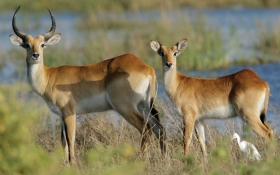
Red Lechwe
Kobus leche leche
Animal Behavior: Male and female lechwe remain separated from each other most of the year. Some males are strongly territorial for part of the year. Females and calves depend on water and are commonly found near wet areas, while males are found at greater distances from water sources. Males compete for their territory during rut. The rest of the year they remain in bachelor herds. There is no definite leader in female groups.
Eating Habits: Lechwe eat nutritional grasses that are found in flooded meadows. They will feed in waters up to their bellies.
Range: The lechwe is found in the southern savanna in Africa, centering around Zambia. They prefer areas of the flood plains that border swamps because they are close to water and food.
Conservation Efforts: Lechwe are listed under US ESA as Threatened and under IUCN as vulnerable. The greatest change was between 1971 - 1987 with the building of hydroelectric dams that changed the natural flooding cycle. Poaching did not cause considerable damage to the population.
Animal Facts: Lechwe have been hunted and poached by humans for profit. Also, lechwe are one of many African mammals that are a tourist attraction. The average lifespan status in the wild is 15 years. The average number of offspring is 1 calf.
